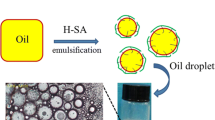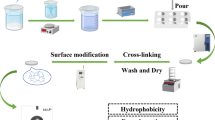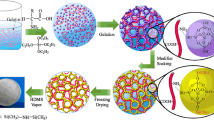Abstract
In order to obtain hydrophobic alginate-based fibrous aerogel, sodium alginate (SA) and acrylamide (AM) as raw materials, methyltrimethoxysilane (MTMS) as surface modification agent. And, hydrophobic alginate-based fibrous aerogel was prepared by soaking sodium alginate / polyacrylamide (PAM) composite hydrogel with methyltrimethoxysilane / ethyl orthosilicate (TEOS) / ethanol mixture. The samples were systematically characterized by SEM, FT-IR, DSC, and so on. The results manifested that the hydrophobic groups successfully introduced into the aerogel, made aerogel possess hydrophobicity, Ca2+ was uniformly dispersed in the aerogel by Ca2+ slow-release crosslinking method. The prepared aerogel showed macroporous and mesoporous microstructure. The bulk density was 0.026 g/cm3, specific surface area was 80 m2/g, the average mesoporous size was 13.18 nm, the average macropore size was 2.25 µm, the total pore area was 39 m2/g, the porosity was 95.6% and the single point total pore volume was 0.528 cm3/g. The hydrophobic alginate-based fibrous aerogel had excellent oil absorption, the adsorption capacity was 65 times as much as its own weight.

Highlights
-
Modified alginate-based fibrous aerogel has remarkable oil absorption.
-
The aerogel prepared by Ca2+ slow-release crosslinking method has a uniform pore structure.
-
Modified alginate-based fibrous aerogel is hydrophobic.







Similar content being viewed by others
References
Pang J, Mo X, Liu Y, Tan D, Zhu Y (2016) The preparation and absorptive properties of oil-absorbent banana fiber/pla aerogel Mod Plast Process Appl 26(2):33–36
Liu Z, Wu P (2018) Preparation of hydrophobic cellulose aerogel beads and its adsorption performance. Chem Ind For Prod 38(1):1–2
Chin SF, Romainor ANB, Pang SC (2014) Fabrication of hydrophobic and magnetic cellulose aerogel with high oil absorption capacity. Mater Lett 115(2):241–243
Lin C, Zhang X, He B et al. (2015) Synthesis and characterization of hydrophobic cellulose aerogel. Nat Sci J Hainan Univ 33(4):353–358
Granström M, Pääkkö MKN, Jin H, Kolehmainen E, Kilpeläinen I, Ikkala O (2011) Highly water repellent aerogels based on cellulose stearoyl esters. Polym Chem 2(8):1789–1796
Korhonen JT, Kettunen M, Ras RHA, Ikkala O (2011) Hydrophobic nanocellulose aerogels as floating, sustainable, reusable, and recyclable oil absorbents. ACS Appl Mater Interface 3(6):1813
Shi J, Lu L, Guo W, Sun Y, Cao Y (2014) An environment‐friendly thermal insulation material from cellulose and plasma modification. J Appl Polym Sci 130(5):3652–3658
Ning C, Qian L, Jin L, Yong W, Bai Y, Szunerits S et al. (2017) Facile synthesis of fluorinated polydopamine/chitosan/reduced graphene oxide composite aerogel for efficient oil/water separation. Chem Eng J 326:17–28
Zhai T, Zheng Q, Cai Z, Xia H, Gong S (2016) Synthesis of polyvinyl alcohol/cellulose nanofibril hybrid aerogel microspheres and their use as oil/solvent superabsorbents. Carbohydr Polym 148:300–308
Karadağ E, Kasim ZD, Kundakcı S, Üzüm ÖB (2017) Acrylamide/potassium 3-sulfopropyl methacrylate/sodium alginate/bentonite hybrid hydrogels: synthesis, characterization and its application in lauths violet removal from aqueous solutions Fibers Polym 18(1):9–21
Huang Y (2017) Preparation of calcium alginate aerogel and its adsorption on heavy metal ions Anqing Norm Univ 22(3):90
Liang YY, Hui-Jun WU, Huang RD, Yang JM (2017) Optimizations of thermal and mechanical properties of silica aerogel composite. Bulletin of the Chin Ceram Soc. 14(5):1693–1699
Oh JK, Perez K, Kohli N, Kara V, Li J, Min Y et al. (2015) Hydrophobically-modified silica aerogels: novel food-contact surfaces with bacterial anti-adhesion properties. Food Control 52:132–141
Sorour MH, Hani HA, Al-Bazedi GA, El-Rafei AM (2016) Hydrophobic silica aerogels for oil spills clean-up, synthesis, characterization and preliminary performance evaluation. J Porous Mater 23(5):1401–1409
Gad YH, Aly RO, Abdel‐Aal SE (2015) Synthesis and characterization of na‐alginate/acrylamide hydrogel and its application in dye removal. J Appl Polym Sci 120(4):1899–1906
Thakur S, Arotiba O (2017) Synthesis, characterization and adsorption studies of an acrylic acid-grafted sodium alginate-based tio 2 hydrogel nanocomposite. Adsorp Sci Technol 36(1):026361741770063
Silva RR, Salvi DTB, Santos MV, Barud HS, Marques LF, Santagneli SH et al. (2016) Multifunctional organic–inorganic hybrids based on cellulose acetate and 3-glycidoxypropyltrimethoxysilane. J Sol Gel Sci Technol 81(1):1–13
Mohd Sokri MN (2015) Polymer-derived amorphous silica-based inorganic–organic hybrids having alkoxy groups: intermediates for synthesizing microporous amorphous silica materials. J Ceram Soc Jpn 123(123):732–738
Li S, Zhang L, Li J, Wu Z, Yang C (2017) Silica nanowires reinforced self-hydrophobic silica aerogel derived from crosslinking of propyltriethoxysilane and tetraethoxysilane. J Sol Gel Sci Technol 83(3):545–554
Wan C, Li J (2015) Embedding zno nanorods into porous cellulose aerogels via a facile one-step low-temperature hydrothermal method. Mater Des 83:620–625
Jian L, Yun L, Yang D, Sun Q, Liu Y, Zhao H (2011) Lignocellulose aerogel from wood-ionic liquid solution (1-allyl-3-methylimidazolium chloride) under freezing and thawing conditions. Biomacromolecules 12(5):1860
Chen Y, Li D (2006) Analysis of error for pore structure of porous materials measured by MIP. Bull Chin Ceram Soc 25(4):198–201
Wei QF, Mather RR, Fotheringham AF, Yang RD (2003) Evaluation of nonwoven polypropylene oil sorbents in marine oil-spill recovery. Mar Pollut Bull 46(6):780–783
Bi H, Xie X, Yin K, Zhou Y, Wan S, He L et al. (2012) Graphene: spongy graphene as a highly efficient and recyclable sorbent for oils and organic solvents. Adv Funct Mater 22(21):4421–4425
Wu ZY, Li C, Liang HW, Chen JF, Yu SH (2013) Ultralight, flexible, and fire-resistant carbon nanofiber aerogels from bacterial cellulose. Angew Chem 125(10):3113–3113
Acknowledgements
We thank Prof. Hong Zhang and all the people involved in the study. This research was financially supported by Liaoning Provincial Institute of Advanced Industrial Science and Technology major projects.
Funding
Liaoning Provincial Institute of Advanced Industrial Science and Technology major projects.
Author information
Authors and Affiliations
Corresponding author
Ethics declarations
Conflict of interest
The authors declare that they have no conflict of interest.
Rights and permissions
About this article
Cite this article
Meng, C., Zhang, H., Zhang, S. et al. The preparation of hydrophobic alginate-based fibrous aerogel and its oil absorption property. J Sol-Gel Sci Technol 87, 704–712 (2018). https://doi.org/10.1007/s10971-018-4748-1
Received:
Accepted:
Published:
Issue Date:
DOI: https://doi.org/10.1007/s10971-018-4748-1




